The Patriot Hellfire M.2 480GB Review: Phison NVMe Tested
by Billy Tallis on February 10, 2017 8:30 AM ESTATTO
ATTO's Disk Benchmark is a quick and easy freeware tool to measure drive performance across various transfer sizes.
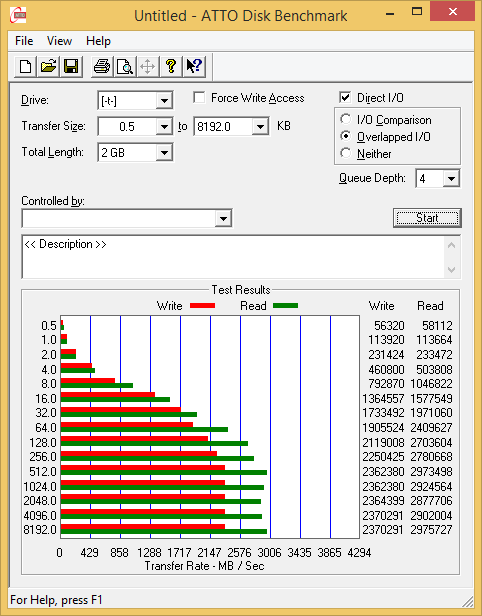 |
|||||||||
With write speeds that exceed 2.3 GB/s and read speeds that almost hit 3 GB/s, the Patriot Hellfire has no trouble delivering very high performance on shorter tests and with compressible data. Performance scales well with transfer size until around 64 kB, after which it takes quite a while for performance to fully saturate.
AS-SSD
AS-SSD is another quick and free benchmark tool. It uses incompressible data for all of its tests, making it an easy way to keep an eye on which drives are relying on transparent data compression. The short duration of the test makes it a decent indicator of peak drive performance.
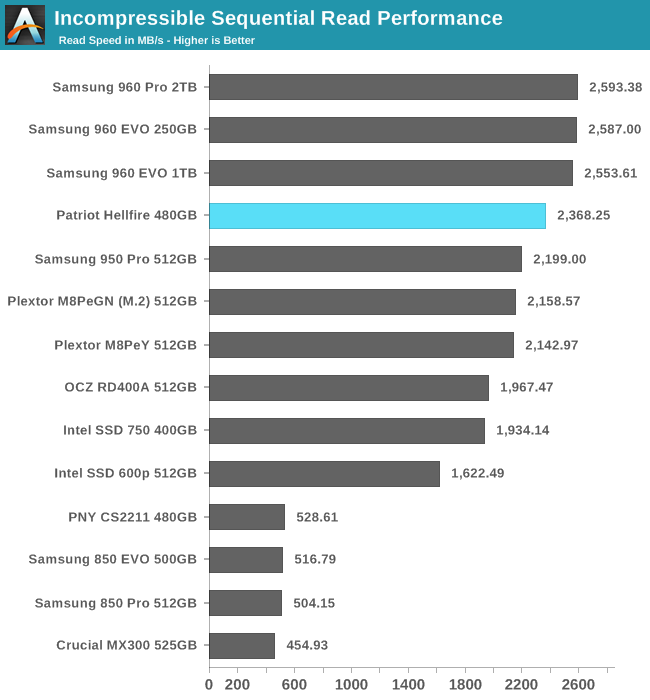
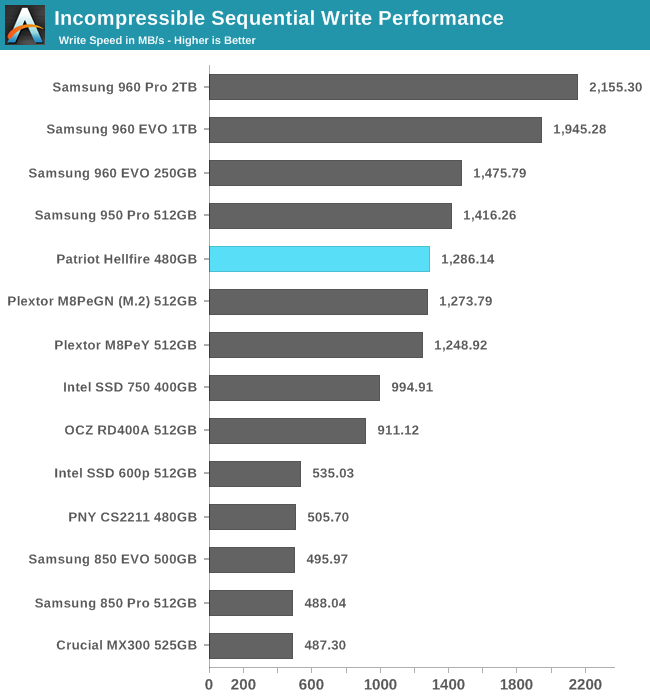
The Patriot Hellfire can't quite keep up with Samsung's latest generation, but it still ties or slightly beats the rest of the competition even though the use of incompressible data slows it down some.
Idle Power Consumption
Since the ATSB tests based on real-world usage cut idle times short to 25ms, their power consumption scores paint an inaccurate picture of the relative suitability of drives for mobile use. During real-world client use, a solid state drive will spend far more time idle than actively processing commands. We report two measures of idle power consumption: active idle where the SSD is not in use but has not been put in to any low-power sleep state, and idle power consumption in the deepest sleep state supported by our testbed. For NVMe SSDs, the lowest drive power state is measured but PCIe Active State Power Management (ASPM) is not used due to limitations of this motherboard. For SATA SSDs, aggressive link power management is used to put the SATA link into slumber state. Many SSDs support a deeper DevSleep state, but this cannot be engaged using ordinary desktop platforms.
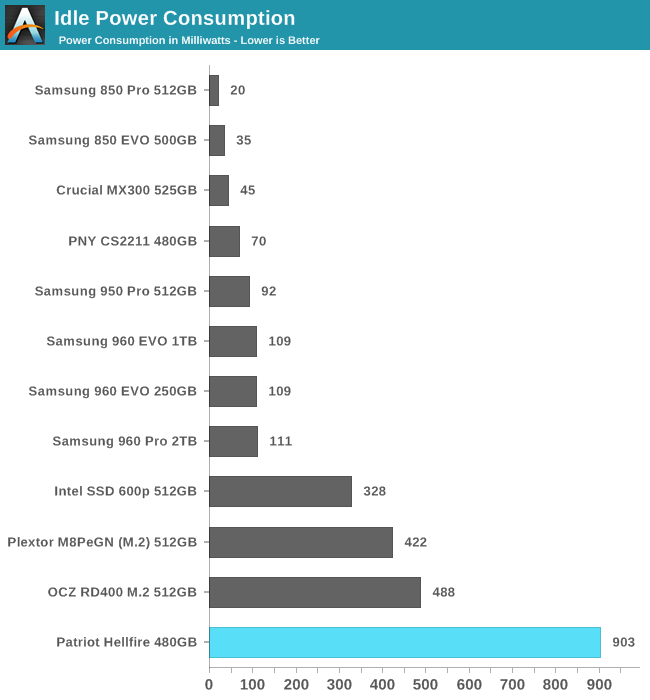
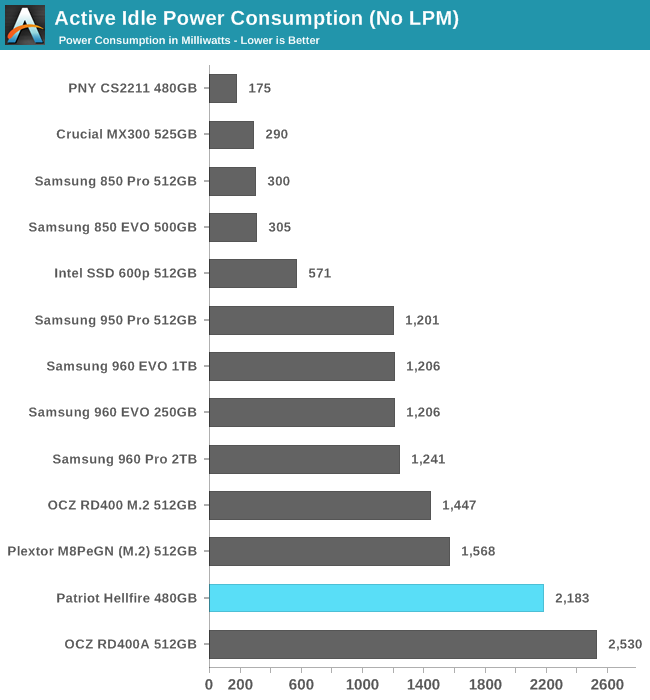
The Patriot Hellfire has by far the worst power management, and is barely able to get below 1 W even in the deepest low-power state. If NVMe power saving is not used, the Hellfire never drops below 2 W. This means the Hellfire starts out any performance test far closer to thermal throttling than any other SSD. (The OCZ RD400A is using slightly more power than the Hellfire because of the overhead of its 12V to 3.3V conversion circuit.)










43 Comments
View All Comments
Magichands8 - Friday, February 10, 2017 - link
The problem is that there's nothing cheap about these. In fact, price per GB for SSDs seems to be going up even for the 'just good enough' crowd! And after all these years capacities are still a joke. To me, those are much bigger concerns than the name given to the drive. But we're going to have to put up with it for quite a while by simply not buying anything. Companies are going to keep doing this as there's apparently a large part of the buying public who are determined to throw pearls before swine on overpriced and low capacity SSDs. At least Patriot has done SOMETHING about the performance aspect.Murloc - Friday, February 10, 2017 - link
you're wrong, I can now buy something double the size and with better performance at the same price I bought my 840 evo.MR_Roberto - Monday, February 27, 2017 - link
ehh? tell me what product that is.. i want to buy it xDphexac - Friday, February 10, 2017 - link
Now, that is one crappy SSD.jjj - Friday, February 10, 2017 - link
You guys should use these traces to measure power consumption in CPU reviews.There is way too much focus on "max load". Guess AT does have some more relevant tests for laptop reviews but in CPU reviews, the power section is tragic.
Billy Tallis - Friday, February 10, 2017 - link
Unfortunately, these traces are just playing back the I/O, not actually re-running the whole application. The CPU load they present is trivial.jjj - Sunday, February 12, 2017 - link
Hmm so that can distort the SSD perf tests a bit for workloads that are CPU heavy.Maybe a dedicated article would be interesting. Even more so when you get Xpoint drives, next year i guess for proper capacities.
Guess the SSD power tests could factor in perf and CPU utilization for extra accuracy.
Billy Tallis - Monday, February 13, 2017 - link
The distortion should be minimal. Recording the traces in the first place incurred very little overhead. The trace doesn't perfectly capture the dependencies between operations, but the playback does preserve the ordering and queue depths and relative timing, except that long disk idle periods are cut short. I'll cover this in detail in when I launch the 2017 test suite.BurntMyBacon - Monday, February 13, 2017 - link
Your efforts are appreciated.jjj - Monday, February 13, 2017 - link
Just to be clear, i was thinking the CPU becoming a bottleneck in some situations and that there might be significant differences in CPU load per unit of perf between SSDs that could lead to significant differences in real usage.